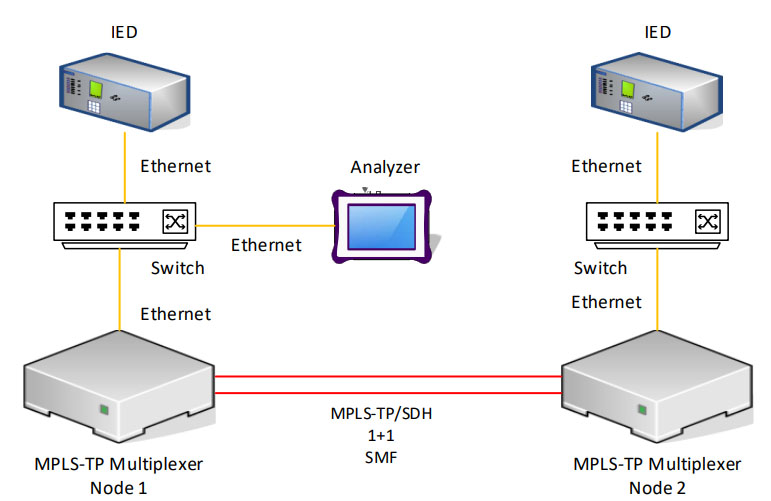Optical Systems Performance for Line Protection Schemes
Abstract
Several telecommunication protocols emerge as optimal for data communications; however, they are not holistic solutions from a quality-of-service point of view. Guaranteed bandwidth and resilient connection are not enough for power transmission needs. For this reason, deterministic and fast message delivery in an Operational Technology (OT) network is being defined and required by different industry standards like IEC 61850, IEC 60834-1, among others.
Protection and control applications are based on very strict operating standards that must be maintained in the telecommunications platform that supports their operation. The key communication requirements of protection schemes should be the starting point in terms of evaluating a telecommunications channel/platform for power transmission. In this paper, we verify the critical parameters that must be provided by an optical communications link in the Multi-Protocol Label Switching – Transport Profile (MPLS-TP) protocol to meet the demand defined by the protection schemes.

Fig1. Network convergence to Ethernet in the Power Grid.
Impedance-based system protection
Line Protection Schemes
Impedance-based system protection is very sensitive to latency and communication channel availability (it is compromised when a ring changes its communication path from primary to protected), while current differential comparison schemes require symmetry that not all forms of packet-switched platforms can guarantee. In that aspect, Multi-Protocol Label Switching – Transport Profile (MPLS-TP) guarantees the required performance for these applications. In line with previous requirements, we validate the latency of teleprotection (integrated version) over a hybrid (TDM and packet switched) multiplexer; also over a C37.94 optical port that would allow the interconnection of an external Current Differential Relay or external teleprotection equipment. Those measurement were performed in the two possible ways the hybrid platform allowed:
- Legacy communication based on Time Division Multiplexing (TDM) format by Synchronous Digital Hierarchy (SDH).
- Packetized OVER Multi-Protocol Label Switching – Transport Profile (MPLS-TP).
In Operational Technology (OT) networks, as is the case of power line protection systems, one of the fundamental requirements is the system availability; one optimal approach to deliver such requirement is the implementation of redundant communication links. The operating environmental conditions also define specific requirements for the telecommunication devices that are aligned with the Intelligent Electronic Devices (IED), which are the basis of reliability in the protection scheme. Present paper presents laboratory and field measurements that support above discussed critical parameters that telecommunication platforms require to serve power transmission protection schemes.

Fig 2. Teleprotection scheme.
Wide Area Monitoring Systems
The performance for Wide Area Monitoring Systems (WAMS) applications will also be evaluated in order to verify the reliability of the MPLS-TP platform for those applications. In this sense, the latency measurement of Generic Object Oriented Substation Event (GOOSE) messages between differential protection equipment was performed. To perform delay and fiber switching tests; we used certification grade analyzers which can analyse TDM, and Ethernet based communications.
Also, will be documented practical results measured on Multi-Protocol Label Switching – Transport Profile (MPLS-TP) equipment comparing these with what is defined in the standards to maintain the safety and reliability of electrical protection schemes.
Protection, control and monitoring applications
Protection, control and monitoring applications are based on strict performance standards that must be maintained in the telecommunications platform that supports their operation. The key communication requirements of protection schemes should be the starting point in terms of evaluating a telecommunications channel/platform for power transmission. Impedance-based system protection is very sensitive to latency and communication channel availability (it is compromised when a ring changes its communication path), while current differential comparison schemes require symmetry that not all forms of packet-switched platforms can guarantee.
In present paper, we report validations of the critical parameters that must be provided by an optical communications link based on Multi-Protocol Label Switching – Transport Profile (MPLS-TP) to satisfy the demand defined by the protection schemes.

Fig 3. GOOSE messaging test setup.
About Protection
The protection of a high voltage power transmission line (based on Impedance Analysis or Current Differential) is very sensitive to latency and the availability of the communication channel (it is compromised when a ring changes its communication path).
- Current Differential: < 3ms
- Impedance Based: 10ms
In this sense, we validated the delay times of the teleprotection integrated in a multiplexer equipment and an optical port that would allow the interconnection of an external Intelligent Electronic Devices (IED) such as Current Differential Relay and/or standalone teleprotection equipment. These measurements were performed in a dual mode as allowed by the hybrid mode that multiplexer operates. Current differential comparison schemes require an asymmetry <1.5 ms according to current differential IED operational alarms that not all forms of packet-switched platforms can guarantee. In that sense the Multi-Protocol Label Switching–Transport Profile (MPLS-TP) format guarantees the required performance for these applications.
In operational technologies (OT), as in the case of a protection system, another fundamental parameter is availability. One of the ways to guarantee this requirement is the implementation of redundant communication links. The Multi-Protocol Label Switching – Transport Profile (MPLS-TP) multiplexer allows the implementation of redundant and independent routes for each service to be implemented (Ethernet, IEEE C37.94, DTT). In following section are shown validation results of the delay, symmetry and channel availability that Integrated Teleprotection and C37.94 port offers to Intelligent Electronic Devices (IED).
xGenius
xGenius is a tester designed for the installation and maintenance of communications in the energy industry. It supports legacy and new generation interfaces to verify Ethernet / IP, MPLS, PTP, NTP, SyncE, ToD, IRIG-B, T1 / E1, C37.94, RS-232, G703 and protocols such as GOOSE, SV or MMS, giving you a perfect vision and control of your infrastructures, improving protection and data collection.

Fig 4. xGenius is tester to verify legacy and new communication protocols.
Download the White Paper
Paper written by:
Jozthdwing RAMIREZ <joz.ramirez@grid-resources.com>
Grid Resources Inc
Jose BORDA
Peru <jose.borda@nakama.com.pe>
Nakama Soluciones
Published at CIGRE @ INFORMATION SYSTEMS, TELECOMUNICATIONS AND CYBERSECURITY (PS3 Meeting the Challenges of Energy Transition with Reliable, Scalable, and Efficient Telecommunications Networks)
